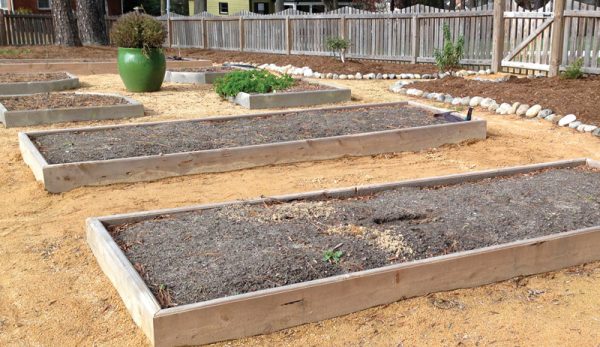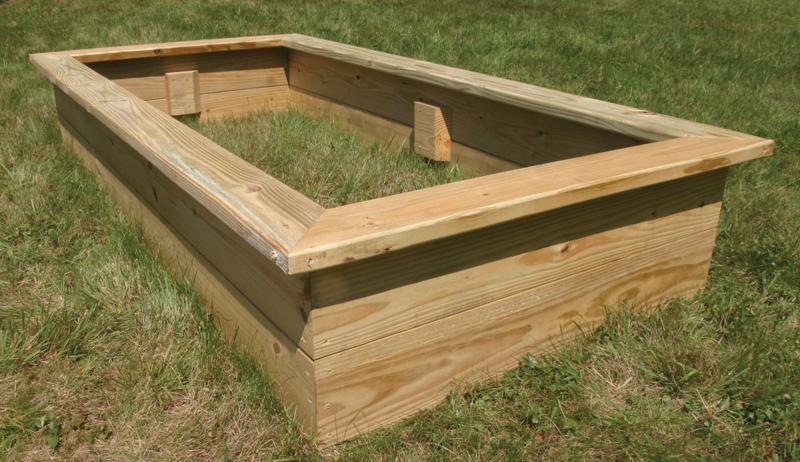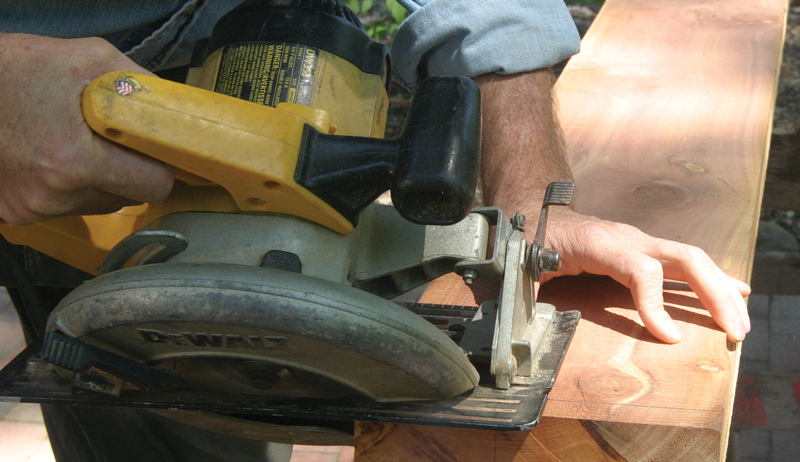
The first thing I learned about home gardening was probably the importance of growing in a raised bed.
As I helped a buddy spread old sawdust and shape up some beds, he taught me the primary reason for gardening this way. In a cold, wet spring, the excess rain would drain out from the raised bed more quickly and spare the vegetables from drowning.
However, raised beds aren’t the answer for every gardener. In dry climates such as the southwestern U.S., for instance, Native American farmers planted vegetables in beds slightly dug out below the natural soil level. This way, the beds gather more of the rare rainwater and reduce the need for irrigation.
What’s the difference between a Permabed and a raised bed? Here’s the answer.
In climates that aren’t as rainy as northwestern Europe and the Pacific Northwest—such as the plains, Midwest and eastern states—raised beds are beneficial during cool, rainy months and during summer downpours.
But during summer dry spells, that quick drainage demands a bit more attention to irrigation and mulching to keep soil moisture levels steady.
But let’s be honest. Part of the reason we have raised beds is because they can add structure and beauty to the garden. Having a neat edge gives us a sense of the garden being under control … even as the weeds are getting away from us.
However, it isn’t absolutely necessary to define a raised bed with lumber. Simply tossing soil from the pathways onto the beds raises them up enough to make a difference. The first raised beds I made for myself were that style.
But because they were about 2 feet wide and 6 feet long, they did resemble burial plots in a cemetery. So, since I acquired basic carpentry skills, I’ve built raised beds with a more permanent and less funereal look.
You can, too.

Types of Wood
You have choices of wood for building raised beds. You could scavenge pine lumber from a construction site or a house demolition. That would be the cheapest way to go.
But if the wood isn’t rot-resistant, termites and fungi will slowly dismantle your beds. So in about five years—sooner in high rainfall, later in a dry climate—you’ll have to start over and rebuild the beds.
You could also build them with wood that is naturally rot-resistant: eastern or western red cedar, redwood, cypress or black locust. The heartwood of these trees could last 20 years or more.
But if the lumber is cut from the sapwood of the tree, it won’t last much longer than salvaged pine boards. Only the darker, denser heartwood of these trees is truly rot-resistant.
The reason? The heartwood is the center of older trees, and those cells of the heartwood are all dead. The live cells of the sapwood—between the bark and the heartwood—send all their waste material to be dumped in the dead cells of the heartwood.
So, yes, that lovely smell of heartwood cedar is the “poop” from the sapwood of cedar.
Unfortunately, planks of these rot-resistant heartwoods aren’t available everywhere. You might need to search lumberyards or high-end lumber suppliers. Even if you can find these planks, they can be pricey.
A more common type that costs less and lasts longer than naturally rot-resistant lumber is pressure-treated wood. Gardeners once rightly shied away from this wood because it was infused with toxic chemicals such as arsenic and chromium.
However, that hasn’t been the case for almost 20 years.
The Environmental Protection Agency pressed lumberyards to switch to a mixture of copper. That’s the same material most water pipes are safely made from and the same product used in kitchen countertop cleaners such as Formula 409.
I believe that is plenty safe for using in garden structures.
You can extend your growing season with a raised bed high tunnel.
Sizes of Raised Beds
The standard width of a raised bed is 4 feet. Any wider and the average gardener can’t reach the center of the bed while standing in the path.
While 4 feet is standard, 3 feet is fine for gardeners without as much reach.
Most often, the bed length is determined by the length of planks a gardener can buy or safely handle. The smallest bed I recommend is a square made from four 2-by-4s, each 4 feet long.
But the size I recommend most often is a bed made of 2-by-8s that is 4 feet wide and 8 feet long. That way, each bed can be made from three 8-foot-long 2-by-8s.
With one 8-footer cut in half, you get the two 4-footers you need for each end of the bed. I like this size because the proportions look right. The planks even fit nicely in a small pickup truck.
You can grow a lot of vegetables in 32 square feet. And the depth lets you add lots of topsoil or compost and mulch while keeping a neat edge.

Tools You’ll Need
Basic carpentry tools will get the job done.
- A corded or cordless drill with an assortment of drill bits and driver bits lets you pre-drill holes and drive 3-inch exterior grade screws into place.Screws are better than nails. You don’t risk smashing your thumb, the boards don’t pull apart over time and you can take the bed apart if you want to move it.
- A circular saw with a new blade will cut everything to length. But circular saws can be loud and intimidating to some, so get some tutoring from an experienced carpenter before using one if it’s your first time.
- Measuring and marking tools are also important. Get a pencil and a speed square for marking cut lines.
- You’ll also want safety gear such as leather gloves to protect your hands from splinters. Also have ear and eye protection to save your hearing and eyesight.
- Cords, sawhorses and clamps round out the simple tools you’ll need for this project.
- Last, you need some open space for the sawhorses and a flat surface such as a patio or driveway for screwing the sides of the beds together.
DIY Instructions
Follow these steps to create a raised bed.
- Mark and cut the very ends of a pair of 8-foot 2-by-8s with a 45-degree bevel. These cuts are more difficult to make than a straight one, so take your time. And clamp your planks to the sawhorse so they don’t shift around.
- Mark and cut the opposite ends with a 45-degree bevel that’s 96 inches from the first cut.
- Take the third 8-foot 2-by-8 and cut one end with a 45-degree bevel.
- From the bevel, mark and cut another 45-degree bevel 48 inches away from the first.
- Flip the leftover piece of that third board. It already has a 45-degree bevel cut at one end.
- Measure, mark and cut a final 45-degree bevel that’s 48 inches away from the first one.
- Put a drill bit that’s slightly wider than the threads of your 3-inch screws in your drill.
- Drill three holes at the end of each board (24 holes total) through the beveled part.The locations don’t have to be precise as long as they are about an inch from all three edges. It’s better if they aren’t precise—that way the screws on one side of a corner won’t conflict with the screws on the other side of the corner.
- Put two corners together on a flat surface such as a patio or driveway.
- Place a scrap of wood—ideally a 2-by-6 or 2-by-8 about 30 inches long—across the corner for you to sit on. Use the speed square to make sure you’ve got a 90-degree corner.Your weight will hold the two corner pieces together and give you a good place to sit from which to drive the screws.
- Place six screws in the six holes. One by one, drill them into place. Use the seating plank and your weight to keep the corner aligned.
- Repeat steps 9, 10 and 11 on the other three corners.
- Recruit someone to help you carry the finished raised bed into the garden. If conditions allow, you might be able to lift one end and drag it in place by yourself.
- Fill the raised bed with topsoil. A 4-by-8-foot bed built with 2-by-8s will hold about 20 cubic feet of topsoil (a cubic yard is 27 cubic feet).
Now that your bed has been raised, plant it up.
Sidebar: Don’t Be Square

Schools, restaurants and churches everywhere are starting their own vegetable gardens. Hostels, too—well, at least one anyway.
Hostels are like hotels but cheaper because they have bunk beds and shared rooms. They are common in Europe but rare in the U.S. outside of the bigger cities.
In an older neighborhood of Charleston, S.C., the manager at the cleverly named NotSo Hostel hostel wanted my help siting a vegetable garden on its mostly shady property. All the spots we initially looked at were under big trees or too close to tall buildings.
Because sunlight is food for plants, putting a vegetable garden in any of these shady spots meant the plants might live, but they wouldn’t thrive. It looked unlikely the hostel’s land could sustain a vegetable garden.
The only sunny spot was the gravel parking lot. I proposed sacrificing one of the 11 angled spaces for a proper vegetable garden.
After her initial shock, the manager came around to the idea. She even thought that the necessary rhomboid shape of the bed would suit the unconventional character of the hostel.
On that visit, I didn’t have enough time to make the garden, so the manager and her staff used scrap wood planks to build the bed and filled it 10-inches deep with rich topsoil.
Vegetable roots only travel down about 6 inches, so they couldn’t reach any petroleum products that might have leaked into the gravel parking lot.
The hostel staff grew lots of tomatoes, herbs, greens and other vegetables there for several years. But in that time, the pine planks had begun to rot away and needed replacing.
To get the hostel’s raised bed back into shape, I brought in some treated 2-by-10s to wrap around the decomposing planks. This new bed will easily last three or four decades.
I then topped those new planks with treated 2-by-6s that made a flat area where gardeners could sit while tending the garden. To give the bed an attractive look evoking the 19th century hostel buildings, I mitered all the corners (picture-frame corners are mitered, for example) and used a router to smooth over the edges.
So what if the bed isn’t square?! It’s deep, durable, sunny and ready to grow. Plus, it’s a model for parking lots everywhere.
This article appeared in Hobby Farm‘s Urban Farm 2019 annual, a specialty publication produced by the editors and writers of Hobby Farms magazine. You can purchase this volume, Hobby Farms back issues as well as special editions such asBest of Hobby Farms and Living off the Grid by following this link.




